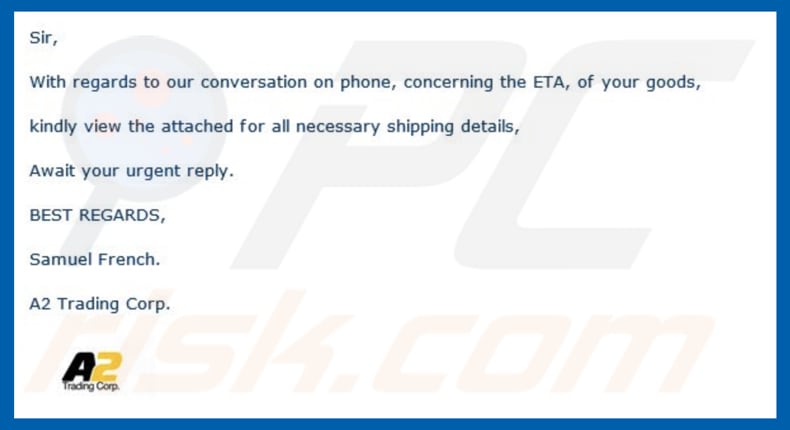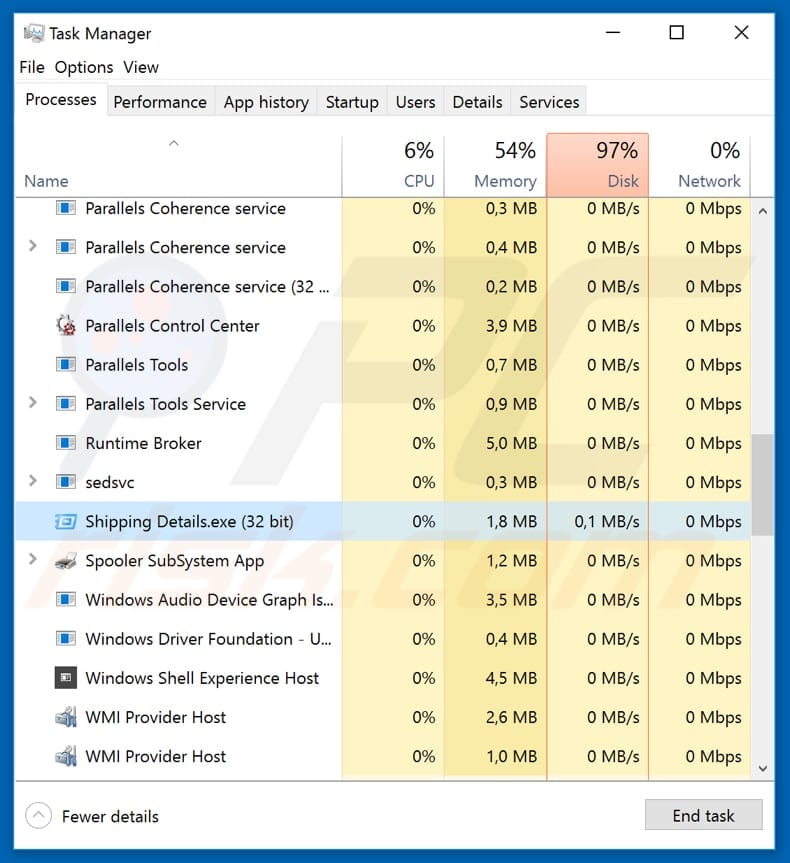Get free scan and check if your device is infected.
Remove it nowTo use full-featured product, you have to purchase a license for Combo Cleaner. Seven days free trial available. Combo Cleaner is owned and operated by RCS LT, the parent company of PCRisk.com.
What is "A2 Trading Corp Email Virus"?
"A2 Trading Corp Email Virus" is a scam (spam email campaign) used by cyber criminals who attempt to trick recipients of the email to download and open an executable file. This then installs LokiBot, trojan-type malware that steals various personal/private data.
We strongly recommend that you ignore the "A2 Trading Corp Email Virus" email and avoid downloading or opening the presented malicious attachment.

Scammers behind this spam campaign claim to be representatives of the A2 Trading Corp company, an electronics wholesaler. Note that this company has nothing to do with the scam. They state that the message regards the estimated time of arrival of goods that the recipient supposedly ordered. Scammers urge users to review the attached shipment document immediately.
The attachment is an archive file called "Shipping Details.ace", which contains a "Shipping Details.exe" executable file. Running this file results in execution of the aforementioned LokiBot malware. Following infiltration, LokiBot records various sensitive data, such as logins and passwords (usually entered into browsers), keystrokes, and other browsing-related data.
Having this virus installed might cause serious privacy issues or even financial loss. Cyber criminals can also use it to proliferate other computer infections. There is a high probability that they will gain access to personal accounts (such as social networks, banks, and so on). These people aim to generate as much revenue as possible.
Therefore, it is highly likely that hijacked accounts will be misused in various ways (e.g., to perform online purchases, money transfers, and so on).
Thus, the presence of LokiBot malware can lead to system infections, significant financial loss, and serious privacy issues. Therefore, do not open web links or download attachments presented in spam campaigns such as "A2 Trading Corp Email Virus" and others.
| Name | A2 Trading Corp spam |
| Threat Type | Trojan, Password stealing virus, Banking malware, Spyware |
| Symptoms | Trojans are designed to stealthily infiltrate victim's computer and remain silent thus no particular symptoms are clearly visible on an infected machine. |
| Distribution methods | Infected email attachments, malicious online advertisements, social engineering, software cracks. |
| Damage | Stolen banking information, passwords, identity theft, victim's computer added to a botnet. |
| Malware Removal (Windows) |
To eliminate possible malware infections, scan your computer with legitimate antivirus software. Our security researchers recommend using Combo Cleaner. Download Combo CleanerTo use full-featured product, you have to purchase a license for Combo Cleaner. 7 days free trial available. Combo Cleaner is owned and operated by RCS LT, the parent company of PCRisk.com. |
There are many spam email campaigns online. Some examples include FORTUNADIGITAL, UNILEVER, and Apple. They are often used to proliferate different computer infections such as Adwind, FormBook, TrickBot, Emotet, and so on.
These malicious programs are used to generate as much revenue as possible by stealing private/sensitive information, proliferating other infections, and so on. Therefore, eliminate these malicious programs immediately.
How did "A2 Trading Corp Email Virus" infect my computer?
In this particular case, computers are infected when a "Shipping Details.ace" archive file is downloaded and the extracted file ("Shipping Details.exe") is executed. In other cases, scammers attach Microsoft Office documents, PDF files, executable files, etc. If the downloaded malicious attachment is an MS Office document, it will request permission to enable macro commands.
Allowing infected documents to enable macros gives them permission to download/install various computer infections. In any case, no email attachment can do any harm if it remains unopened.
How to avoid installation of malware?
Do not download attachments or click web links in emails sent from unknown, suspicious addresses. The same applies to emails containing information that is irrelevant or does not concern you. Bear in mind that most scammers use well-known company names to give the impression of legitimacy.
Often, having reputable anti-virus or anti-spyware software installed (and enabled) allows users to keep their computer safe from infections. If you have already opened the "A2 Trading Corp Email Virus" attachment, we recommend running a scan with Combo Cleaner Antivirus for Windows to automatically eliminate infiltrated malware.
Text presented in the "A2 Trading Corp Email Virus" email message:
Subject: {Possible Spam?} ETA SHIPPING DOCUMENTS 220_10
Sir,
With regards to our conversation on phone, concerning the ETA, of your goods,
kindly view the attached for all necessary shipping details,
Await your urgent reply.
BEST REGARDS,
Samuel French.
A2 Trading Corp.
Screenshot of a LokiBot process ("Shipping Details.exe") in Windows Task Manager:

Instant automatic malware removal:
Manual threat removal might be a lengthy and complicated process that requires advanced IT skills. Combo Cleaner is a professional automatic malware removal tool that is recommended to get rid of malware. Download it by clicking the button below:
DOWNLOAD Combo CleanerBy downloading any software listed on this website you agree to our Privacy Policy and Terms of Use. To use full-featured product, you have to purchase a license for Combo Cleaner. 7 days free trial available. Combo Cleaner is owned and operated by RCS LT, the parent company of PCRisk.com.
Quick menu:
- What is A2 Trading Corp spam?
- Types of malicious emails.
- How to spot a malicious email?
- What to do if you fell for an email scam?
Types of malicious emails:
![]() Phishing Emails
Phishing Emails
Most commonly, cybercriminals use deceptive emails to trick Internet users into giving away their sensitive private information, for example, login information for various online services, email accounts, or online banking information.
Such attacks are called phishing. In a phishing attack, cybercriminals usually send an email message with some popular service logo (for example, Microsoft, DHL, Amazon, Netflix), create urgency (wrong shipping address, expired password, etc.), and place a link which they hope their potential victims will click on.
After clicking the link presented in such email message, victims are redirected to a fake website that looks identical or extremely similar to the original one. Victims are then asked to enter their password, credit card details, or some other information that gets stolen by cybercriminals.
![]() Emails with Malicious Attachments
Emails with Malicious Attachments
Another popular attack vector is email spam with malicious attachments that infect users' computers with malware. Malicious attachments usually carry trojans that are capable of stealing passwords, banking information, and other sensitive information.
In such attacks, cybercriminals' main goal is to trick their potential victims into opening an infected email attachment. To achieve this goal, email messages usually talk about recently received invoices, faxes, or voice messages.
If a potential victim falls for the lure and opens the attachment, their computers get infected, and cybercriminals can collect a lot of sensitive information.
While it's a more complicated method to steal personal information (spam filters and antivirus programs usually detect such attempts), if successful, cybercriminals can get a much wider array of data and can collect information for a long period of time.
![]() Sextortion Emails
Sextortion Emails
This is a type of phishing. In this case, users receive an email claiming that a cybercriminal could access the webcam of the potential victim and has a video recording of one's masturbation.
To get rid of the video, victims are asked to pay a ransom (usually using Bitcoin or another cryptocurrency). Nevertheless, all of these claims are false - users who receive such emails should ignore and delete them.
How to spot a malicious email?
While cyber criminals try to make their lure emails look trustworthy, here are some things that you should look for when trying to spot a phishing email:
- Check the sender's ("from") email address: Hover your mouse over the "from" address and check if it's legitimate. For example, if you received an email from Microsoft, be sure to check if the email address is @microsoft.com and not something suspicious like @m1crosoft.com, @microsfot.com, @account-security-noreply.com, etc.
- Check for generic greetings: If the greeting in the email is "Dear user", "Dear @youremail.com", "Dear valued customer", this should raise suspiciousness. Most commonly, companies call you by your name. Lack of this information could signal a phishing attempt.
- Check the links in the email: Hover your mouse over the link presented in the email, if the link that appears seems suspicious, don't click it. For example, if you received an email from Microsoft and the link in the email shows that it will go to firebasestorage.googleapis.com/v0... you shouldn't trust it. It's best not to click any links in the emails but to visit the company website that sent you the email in the first place.
- Don't blindly trust email attachments: Most commonly, legitimate companies will ask you to log in to their website and to view any documents there; if you received an email with an attachment, it's a good idea to scan it with an antivirus application. Infected email attachments are a common attack vector used by cybercriminals.
To minimise the risk of opening phishing and malicious emails we recommend using Combo Cleaner Antivirus for Windows.
Example of a spam email:

What to do if you fell for an email scam?
- If you clicked on a link in a phishing email and entered your password - be sure to change your password as soon as possible. Usually, cybercriminals collect stolen credentials and then sell them to other groups that use them for malicious purposes. If you change your password in a timely manner, there's a chance that criminals won't have enough time to do any damage.
- If you entered your credit card information - contact your bank as soon as possible and explain the situation. There's a good chance that you will need to cancel your compromised credit card and get a new one.
- If you see any signs of identity theft - you should immediately contact the Federal Trade Commission. This institution will collect information about your situation and create a personal recovery plan.
- If you opened a malicious attachment - your computer is probably infected, you should scan it with a reputable antivirus application. For this purpose, we recommend using Combo Cleaner Antivirus for Windows.
- Help other Internet users - report phishing emails to Anti-Phishing Working Group, FBI’s Internet Crime Complaint Center, National Fraud Information Center and U.S. Department of Justice.
Share:

Tomas Meskauskas
Expert security researcher, professional malware analyst
I am passionate about computer security and technology. I have an experience of over 10 years working in various companies related to computer technical issue solving and Internet security. I have been working as an author and editor for pcrisk.com since 2010. Follow me on Twitter and LinkedIn to stay informed about the latest online security threats.
PCrisk security portal is brought by a company RCS LT.
Joined forces of security researchers help educate computer users about the latest online security threats. More information about the company RCS LT.
Our malware removal guides are free. However, if you want to support us you can send us a donation.
DonatePCrisk security portal is brought by a company RCS LT.
Joined forces of security researchers help educate computer users about the latest online security threats. More information about the company RCS LT.
Our malware removal guides are free. However, if you want to support us you can send us a donation.
Donate
▼ Show Discussion